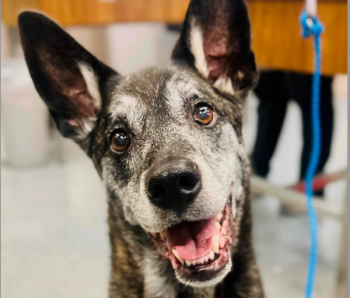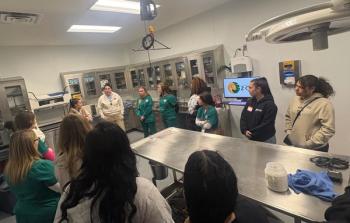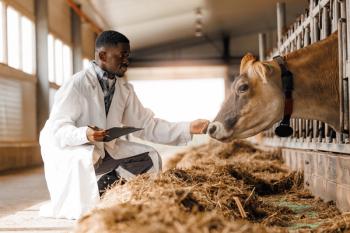
Ohio State satellite clinic upsets local veterinarians
New suburban hospital offers 24-hour emergency care and specialty referral services.
The Ohio State Veterinary Medical Center at Dublin opened in April much to the dismay of some alumni and local Columbus veterinarians.
The Ohio State University College of Veterinary Medicine sells university logo scrubs on its website. Choose from red or gray—extra-small to five-times-extra-large—at $35 a set. “We won’t wear OSU scrubs anymore,” says Becky Salinger, DVM, a 1997 graduate and co-owner of Austinburg Veterinary Clinic in Austinburg, Ohio.
Her practice is nearly 200 miles from her alma mater in Columbus, Ohio, where the college of veterinary medicine recently launched a new emergency and specialty clinic in the suburb of Dublin. Despite the distance, Salinger and many other local veterinarians—most of them alumni—are, to put it nicely, disappointed.
The Ohio State Veterinary Medical Center at Dublin is a 10,000-square-foot, 24-hour emergency facility staffed with surgical and internal medicine specialists. Opponents say the facility, funded by low-interest loans from the university, creates an uneven playing field. The fact that many local veterinarians didn’t hear about the clinic until it was a done deal didn’t help.
“What I find disturbing about the whole thing is as a private practice owner I spend the majority of the money I make paying for my facility,” says Gary Rybka, DVM, owner of Bethel Animal Hospital in Columbus. “It’s a slap in the face that my tax money paid for their facility without even a whisper.”
Collegiate competition
Ohio State College of Veterinary Medicine spokesperson Melissa Weber says the university put a satellite clinic off-campus to better serve its clients. Many pet owners didn’t particularly want to come to Ohio State Veterinary Medical Center on campus, so a satellite location in the suburbs was the answer. “Parking is a whole lot easier,” Weber says.
The university sold bonds to fund the approximately $2 million project. “We took a loan out from the university—it’s one of those very complex university budget things,” Weber says. “It’s at a nice low interest rate.”
And that’s what eats at local practice owners. Bill DeHoff, DVM, a 1964 graduate who’s a stakeholder in MedVet Medical and Cancer Centers for Pets in Worthington, says that from a business standpoint, the school has an unfair advantage. “Ohio State using their name and their money is a privilege status. It changes the playing field,” DeHoff says.
Salinger remembers hard times buying food on credit so she could also buy diapers for her daughter and pay off her school and practice loans. A university-funded facility generates no such challenges. “They’ve got tax money backing them,” she says. “We don’t.”
Rybka has owned a practice in Columbus for the past 20 years and says he could have benefited tremendously from a lower interest rate on his loan. “Did anybody give me the opportunity to do that?” he asks. “Hell, no.”
He continues, “I can see a private practice move across from my clinic. I’m not going to like it and he doesn’t have to ask me, but he’s playing on the same field that I am. Financially he’s taking a huge risk. Not taking that same risk on the same playing field is unfair.”
The Columbus area has no shortage of veterinary clinics—in fact, it has the highest concentration in the state. Two specialty hospitals, Capital Veterinary Referral and Emergency Center and DeHoff’s MedVet Medical and Cancer Center, are less than 10 miles from Ohio State’s new location. Weber acknowledges this but says there are enough pet owners to go around. “It’s a big pie,” she says. “There are several suburban communities just booming. There was just a belief that there were a lot of potential clients in that area.”
Robert Knapp, DVM, who owns Knapp Veterinary Hospital in Columbus, graduated from OSU in 1992, serves as treasurer of the alumni group and sits on the school’s practice advisory board, also says he thinks there’s enough business for everyone. “I’m hoping all this is a bunch of nothing,” he says. “If we look at this a year or two from now, things will be OK. We’ll wonder why we got so worried.”
The Buckeye brand
DeHoff isn’t buying it. “Ohio State brings in the brand and their free money and it impacts all the practices in this area in a big way, whether they understand it that way or not,” he says. Even without the perceived financial advantage, he says no one can compete with the university’s halo of prestige. “The Ohio State brand is a powerful brand,” DeHoff says.
Rybka sends his referrals to Capital Veterinary Referral and Emergency Center, but he’s concerned that clients will be lured to the new satellite by the Ohio State name. “It’s unfortunate for practices who have an established relationship with Capital or someplace else,” Rybka says. “We’re going to have customers say, ‘We’d like to go over to Ohio State.’ In the past we’ve been able to pick.”
Knapp doesn’t see that as a problem. He refers patients to both MedVet and Ohio State. He says the quality of medicine is excellent at both places, so it really comes down to choosing the right place for the client and patient based on their needs. “The benefit in the local area is increased choice,” he says.
Salinger doesn’t see it that way. She says alumni don’t want to compete with their alma mater. “You’ve got this brand name that no one can compete with and we don’t want to,” Salinger says. “We look up to Ohio State as the best.”
She says it’s especially frustrating because she feels the clinic itself strays from the college’s educational mission. “If it was going to be a place where they were going to teach kids, that would be different,” she says. “But they’re doing it for money.”
None of the staff at the satellite is Ohio State faculty. Student rotations, which won’t begin until spring 2014 at the earliest, will be elective and strictly observational, unlike the hands-on approach at the campus hospital.
Weber says client feedback has indicated that student involvement makes appointments too long. She maintains that the satellite will still offer an educational experience, giving students a glimpse of how a specialty hospital runs and allowing them to see the business and communications side of private practice.
Rybka disagrees. “If they want to see how a private practice is run then the students need to go to a true private practice,” he says.
DeHoff asserts that if the university had established a satellite in Toledo where more specialty care is needed, it might have been more palatable. Though he concedes, “The principal of it is what offends my moral fiber here.”
Likewise, Rybka says the courtesy of fair warning would have been appreciated. “They should have discussed this or shared this with the entire veterinary community,” he says. Though he too says that if Ohio State had notified him ahead of time, it wouldn’t have changed his opinion.
A plan for profit
“One of the major driving forces to open this satellite clinic has been our increasing small animal caseload,” reads a statement from Lonnie King, DVM, dean, Ruth Stanton chair of the College of Veterinary Medicine, and executive dean of health sciences colleges, who would not agree to speak directly with dvm360. “We routinely turn away or delay patient appointments for medicine and surgery services.”
Despite this ever-growing caseload, though, the university says times are tough financially. The most recent strategic plan for the veterinary school lists aging facilities, faculty recruitment and retention difficulties, and insufficient funds as challenges.
Plus, state budgets have been cut and expenses have grown, leaving the college no money for expansion, Weber says. The original facility at the hospital on campus is 38 years old. The college launched a $25 million capital fundraising campaign in 2012, but according to the college’s strategic plan, “enhanced earnings operations”—such as the new satellite clinic—will also be needed to generate revenue.
“The opening of the satellite facility is mission-critical,” the dean’s statement says. “Up to 11 other schools and colleges of veterinary medicine are pursuing various types of satellite clinics to provide better service to their referring veterinarians and clients, and to augment their educational programs. The majority of our alumni understand that this is part of our effort to remain a national leader in veterinary medicine.”
This includes Knapp. He feels like he’s giving back to his university by referring patients to its hospital and clinic. “There’s some money going back to the college for renovations, student support, financial support,” Knapp says. He says with continued decreases in state funding, schools get stuck between a rock and hard place. “There are only so many places they can generate revenue.”
Of course, tuition is one place. The strategic plan states that the college is “making maximal use of student tuition as a source of operating revenue.”
However, it goes on to say that relying on tuition increases places an excessive burden on students and is not a viable long-term revenue generator. Be that as it may, the school has increased class sizes. There were 137 graduates in the class of 2013. The incoming class has 162.
Expansive education
Salinger, DeHoff and Rybka worry that the Ohio State satellite clinic is just the first step toward more “enhanced earnings operations” by the university.
There is concern that the college is interested in opening a general practice.Weber says there are currently no plans for a general clinic. “They did not want to compete directly with alumni and referral veterinarians,” she says.Salinger’s not convinced. She says she challenged the veterinary school dean on the possibility of a general practice during a recent alumni tour. “Nothing’s off the table,” she says King replied.
“It’s very personal when you see what’s happening,” Salinger says. “You always looked up to Ohio State. We always felt we were the best in the state. It’s The Ohio State University. You can’t look at it that way anymore.”
Rybka agrees. “I don’t have any respect for Ohio State,” he says. “We work hard, we play by the rules, and I think most of us try for a professional level of courtesy. Why didn’t the university extend at least professional courtesy? Who do they think they are? Why is that OK?”
For Salinger, the conflict cuts deep into her sense of identity. “We look out for our own—that’s being a Midwesterner; that’s being a Buckeye,” she says.
“They’re not—they’re looking out for themselves.”
Newsletter
From exam room tips to practice management insights, get trusted veterinary news delivered straight to your inbox—subscribe to dvm360.






